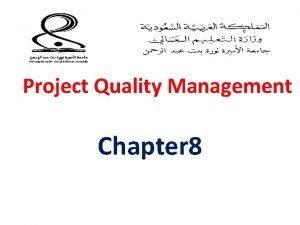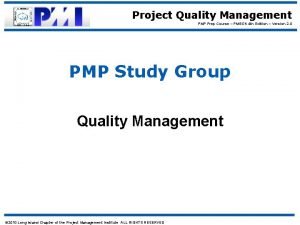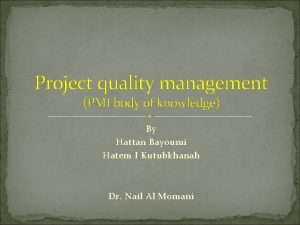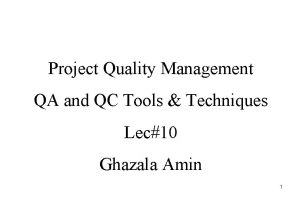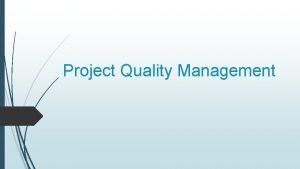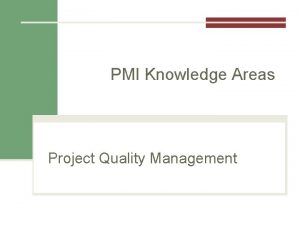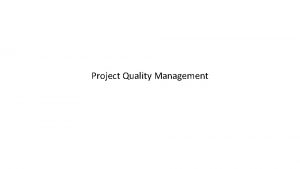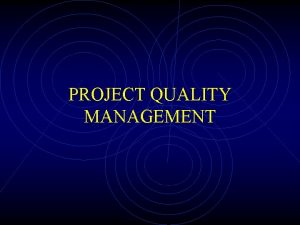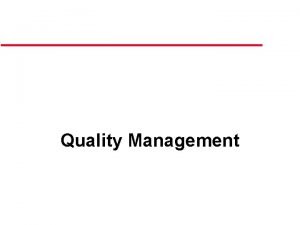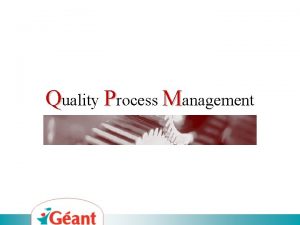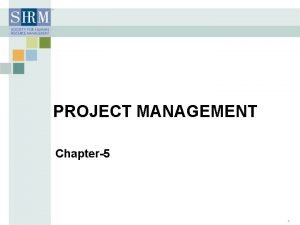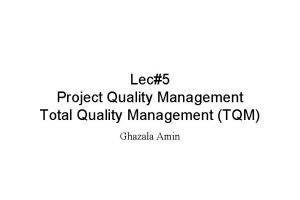Project quality What Is Project Quality Management The













- Slides: 13

Project quality

What Is Project Quality Management? • The International Organization for Standardization (ISO) defines quality as the totality of characteristics of an entity that bear on its ability to satisfy stated or implied needs • Other experts define quality based on • conformance to requirements: meeting written specifications • fitness for use: ensuring a product can be used as it was intended

Quality Objectives • Quality objectives Based on the quality policy of the organization and the needs of consumers, general manager of the organization establishes overall objectives in the field of quality and how to achieve them: • Increased effectiveness; • Increasing market share; • Increase customer satisfaction; Improve Communication

Quality objectives are complementary to other objectives of the Organization: • Market share; • Finance; • Profit; • Environment; • Social issues.

Quality management principles • The principle of customer orientation • The principle of leadership • The principle of employee involvement • The principle of process-based approach

Project Quality Management Processes • Quality planning: identifying which quality standards are relevant to the project and how to satisfy them • Quality assurance: evaluating overall project performance to ensure the project will satisfy the relevant quality standards • Quality control: monitoring specific project results to ensure that they comply with the relevant quality standards while identifying ways to improve overall quality

Quality Planning • It is important to design in quality and communicate important factors that directly contribute to meeting the customer’s requirements • Design of experiments helps identify which variable have the most influence on the overall outcome of a process

planning • - quality policy (intentions or general guidelines of the organization); • - defining the scope of the project (goals); • - product description (technical characteristics); • - standards and regulations that affect the project; • - outputs of other processes. TOOLS, COST-BENEFIT, FLOWCHARTS, BENCHMARKING

Quality Assurance • Quality assurance includes all the activities related to satisfying the relevant quality standards for a project • Another goal of quality assurance is continuous quality improvement • Benchmarking can be used to generate ideas for quality improvements • Quality audits help identify lessons learned that can improve performance on current or future projects

Quality Control • The main outputs of quality control are • acceptance decisions • rework • process adjustments • Some tools and techniques include • • pareto analysis statistical sampling quality control charts testing

Quality related costs • The quality of the projects costs The quality of projects is not an end in itself, but making an analysis we can say that the deviations from quality, but also measures for planning, assurance and quality control should be valued in monetary terms as follows: • • Non-quality costs which may be external or internal causes; • o An external cause - expenditure arising from guarantees, compensation and penalties paid o • Internal cause – expenditure arising from irregularities in quality that can take the form of extra costs for reworking, retouching, retest, scrap, etc. . •

• Quality Costs can be differentiated as follows: • A quality planning costs for the study and prevention of errors; • The insurance costs for project performance evaluation; • A quality control costs, which represents the whole expenditure for quality monitoring.

ISO Standards • ISO 9001 is a quality system standard that: • continuous cycle of planning, controlling, and documenting quality in an organization • Provides minimum requirements needed for an organization to meet its quality certification standards • Helps organizations around the world reduce costs and improve customer satisfaction
 Traditional project management vs modern project management
Traditional project management vs modern project management Pmbok quality assurance vs quality control
Pmbok quality assurance vs quality control Project quality management definition
Project quality management definition What are quality standards in project management
What are quality standards in project management Project quality management lecture notes
Project quality management lecture notes Perform quality control
Perform quality control Flowcharting pmp
Flowcharting pmp Qcc tools and techniques
Qcc tools and techniques Quality management pmp
Quality management pmp Information technology project management 8th edition
Information technology project management 8th edition Project management quality control
Project management quality control Project management quality tools
Project management quality tools Importance of project quality management
Importance of project quality management Hát kết hợp bộ gõ cơ thể
Hát kết hợp bộ gõ cơ thể


